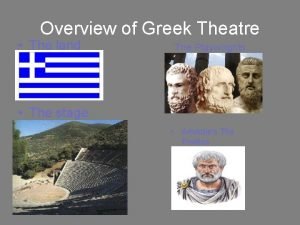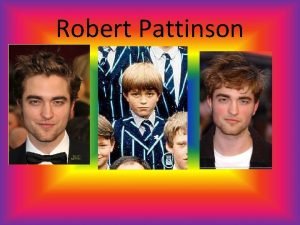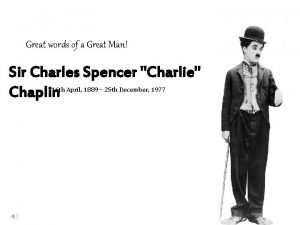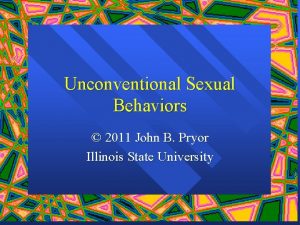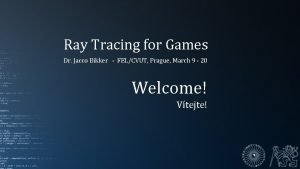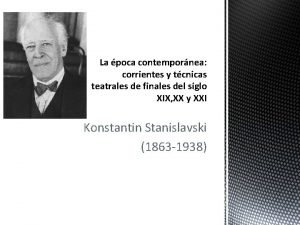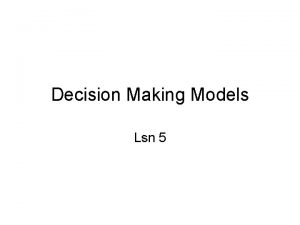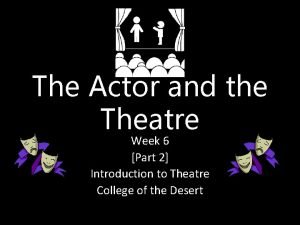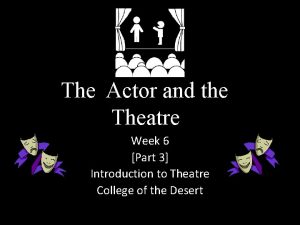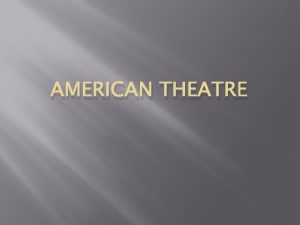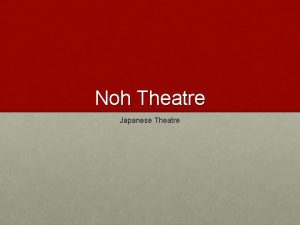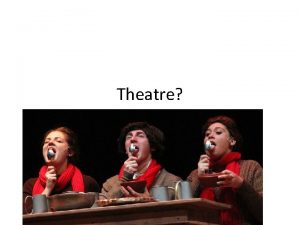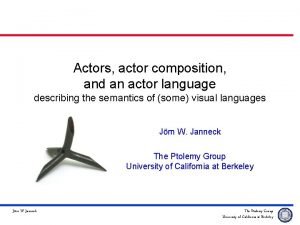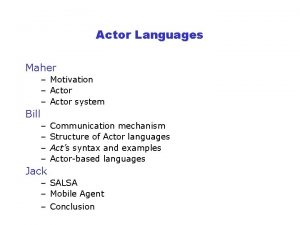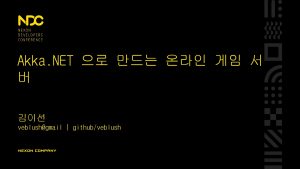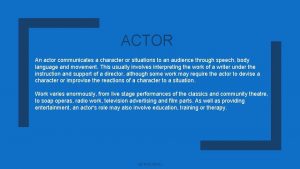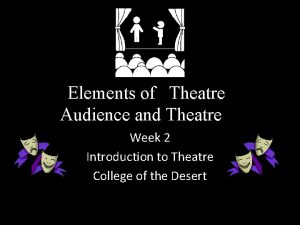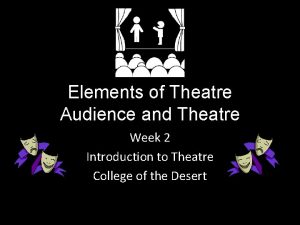The Actor and the Theatre Week 6 Part
![The Actor and the Theatre Week 6 [Part 1] Introduction to Theatre College of The Actor and the Theatre Week 6 [Part 1] Introduction to Theatre College of](https://slidetodoc.com/presentation_image_h/36441a305d13569ed016c3ebb67f045b/image-1.jpg)




















- Slides: 21
![The Actor and the Theatre Week 6 Part 1 Introduction to Theatre College of The Actor and the Theatre Week 6 [Part 1] Introduction to Theatre College of](https://slidetodoc.com/presentation_image_h/36441a305d13569ed016c3ebb67f045b/image-1.jpg)
The Actor and the Theatre Week 6 [Part 1] Introduction to Theatre College of the Desert

Elements of Acting • • Acting is the most visible element of theatre; it seems to personify theatre. Thespis – considered to be the first actor – thus the term thespian was born! In 554 BC, acting was not really widely a "profession" till the 16 th century. Acting involves a sophisticated role – playing and make-believe, pretending, conveyed through doing – enacting on the stage a vision of life. Acting is an impersonation – usually at the service of a script; though not always a script. Acting can be considered as a "pure art": the artist and the instrument are the same. Acting consists of: – A series of tasks, usually in a situation or context – Done usually as someone else – Imaginary – at least part of it • • The actor must discover the essence of a character and project that essence to the audience. The essence of the character has been perceived differently, however, at different times, periods, styles, and cultures, and by different personalities of actors.

The History of Acting Methods • "The Paradox of the Actor" – an essay written by Denis Diderot (1713 -1784) – begins to approach part of the actor's challenge: – “to appear real, the actor must be artificial. ” • Before this, there was not much of a specifically acknowledged approach to acting. • Francois Delsarte (1811 -1871) – devised a system of expression that reduced emotions to a series of fixed poses and attitudes, achieved through body and voice – became methodistic and unworkable, but the American Academy of Dramatic Arts, founded in 1894 was founded on Delsarte principles. • The American Mime Theatre, which held some classes at The American Academy, approaches acting in a similar, though certainly not exact, manner. • Modern "realistic" acting is based much on Constantin Stanislavsky’s (1863 -1938) method acting.

Who is Francois Delsarte? • Francois Delsarte was a French teacher of acting and singing. • He studied singing (1825– 29) at the Paris Conservatoire and appeared as a tenor at the Opéra-Comique, but faulty training had damaged his voice. • Delsarte formulated certain principles of aesthetics that he applied to the teaching of dramatic expression. • He set up rules coordinating the voice with the gestures of all parts of the body.


Who is Constantin Stanislavsky? According to thoughtco. com: • Constantin Stanislavsky was born on January 17 th, 1863 and died August 7 th, 1938. • Before he adopted the stage name "Stanislavsky, " he was Constantin Sergeyvich Alekseyev, a member of one of the wealthiest families in Russia. • According to his autobiography, My Life in Art, he was enchanted by theater at an early age. During his childhood, he adopted a love of puppet theater, ballet, and opera. During adolescence he developed a love of theater; he defied the expectations of family and social class by becoming an actor. • He dropped out of drama school after only several weeks of instruction. The style of the day called for unrealistic, over-dramatic performances. It was a style he loathed because it did not truly convey human nature. • Working with directors Alexander Fedotov and Vladimir Nemirovich. Danchenko, Stanislavsky would eventually co-found the Moscow Art Theatre in 1898. • His international success in the early 1900 s is tied to the rise of Anton Chekhov's popularity as a playwright. • Chekhov, already a beloved storyteller, vaulted to higher levels of fame with his unique comedic dramas, The Seagull, Uncle Vanya, and The Cherry Orchard. Each production of Chekhov's major plays was overseen by Stanislavsky, who realized early on that Chekhov's characters could not be effectively brought to life on stage by traditional means. • Stanislavsky felt that the best performances were the most natural and realistic ones. Hence, his method developed, revolutionizing acting techniques throughout Europe, and eventually the world. • Constantin Stanislavsky, famed Russian actor, director, and teacher, profoundly influenced theater of the 20 th century and beyond. • Throughout his long life, he developed a variety of techniques that became known as "The Stanislavsky System" or "The Method. " • His books My Life in Art (an autobiography), An Actor Prepares, Building a Character, and Creating a Role are still studied today.

What is the Stanislavsky System? • • • Although very complex, one of the basic goals of the "Stanislavsky System" was to portray believable, natural people on stage. This notion was a striking contrast to thespians in 19 th century Russia. Most of the actors during that era spoke in a lavish tone, and gestured in an over-the-top manner. Stanislavsky (also spelled "Konstantine Stanislavski") helped to change much of that. In many ways, Stanislavsky is the father of today's style of “Method Acting, ” a process in which actors immerse themselves into their characters as much as possible.

Elements of his Method • The "Magic If“ – A simple way of beginning the Stanislavsky Method is to ask yourself "What would I do if I were in this situation? " This is a good way to consider natural reactions to the events in the story. – However, Stanislavsky also realized that these types of "what if" questions do not always lead to the best characterization. "What would I do? " might be a very different question from "What would Hamlet do? " Still, it's a good place to begin.

Elements of his Method • Re-Education – Actors must rethink the way they move and talk while onstage. – Being onstage in front of a large audience can be an intimidating experience – certainly not part of most people's everyday lives. – Theater began in Ancient Greece with masks and choreographed sequences; styles may have changed in subsequent centuries, but they were still characterized by an actor's over-emphasis found in early theater. – However, in real life, we don't behave that way. – Stanislavsky compelled actors to find ways to exhibit true-to-life human nature, while still being able to project loudly enough for audiences to hear.

Elements of his Method • Observation – Stanislavsky was the ultimate people-watcher. He encouraged his students to carefully observe others, focusing on their physical traits just as much as their personalities. – After studying everyday people, he would often disguise himself as a peasant or an old man, and interact with the townspeople to see how well he could fit in. Every person is unique. Therefore, every character should exhibit unique traits – many of which can be inspired and adapted from an actor's observation.

Elements of his Method • Motivation – It's become a cliché actor's question – What is my motivation? – Yet, that is precisely what Stanislavsky expected his actors to consider. • • Why does the character say this? Why does the character move to this part of the stage? Why does she turn on the lamp light? Why does he take a gun out of the drawer? – Some actions are obvious and easy to explain. Others can be mysterious. – Maybe the playwright doesn't even know. (Or maybe the playwright was just lazy and needed someone to move a chair across the stage for the sake of convenience. ) – The actor must study the text thoroughly to determine the motivation behind a character's words and actions.

Elements of his Method • Emotional Memory – Stanislavsky didn't want his actors to simply create a reproduction of an emotion. He wanted his actors to actually feel the emotion. – So, if a scene called for extreme grief, actors needed to put themselves in the mindset of the character's situation so that they genuinely experience the feelings of intense sadness. (The same goes for all the other emotions. ) – Sometimes, of course, the scene is so dramatic and the character so human that these intense emotions come naturally to the actor. – However, for actors not able to connect with the character's emotional state, Stanislavsky advised performers to reach into their personal memories and draw upon a comparable life experience.

Stanislavsky's Legacy • Stanislavsky's Moscow Theater thrived during the days of the Soviet Union, and it even continues today. • His method of acting has influenced many other renowned drama teachers including: – Stella Adler – Lee Strasberg – Uta Hagen • History of Stanislavsky's Moscow Theater – https: //youtu. be/ehe. DFPv. Uhjs • Jared Leto on Method Acting – https: //youtu. be/Wgnl 9 ZLQh. AE • Some of the best method actors – https: //youtu. be/q. Qt 93 Iu. Tr. Rg

Who is Stella Adler? • • • Actor, Director, Educator (Nov 29, 1901 - Dec 21, 1992) KNOWN FOR: Co-founder of The Group Theater, founder Stella Adler Theater Studio From 1905, at the age of four, until her death eighty-seven years later, Stella Adler dedicated herself to understanding theater. The child of actors Sarah and Jacob Adler, Stella began her career in the Yiddish theater. In 1931, she met her second husband Harold Clurman, one of the co-founders of the Group Theater. – The Group Theater was a cooperative ensemble dedicated to reinvigorating theater with plays about important contemporary topics. The Group also believed in a theater that would probe the depths of the soul. Both the politics and the cooperative energy of the company appealed to her and she joined in 1931. Leaving briefly to study with Constantin Stanislavsky, who instructed a mode of acting, the predecessor to “method acting, ” in 1934, she returned to the group with a new idea of what American theater could be. By the mid-40’s Adler was teaching at the New School for Social Research and had found the role that was to make her a revered name among actors everywhere. In 1949, she started a school for acting that would last five decades and touch every part of American Theater. Combining what she had learned from the Yiddish theater, Broadway, Hollywood, and Stanislavsky, she opened the Stella Adler Theater Studio (later renamed the Stella Adler Conservatory of Acting). Among those to study at the conservatory were: – Marlon Brando – Robert De Niro – Warren Beatty

Who is Stella Adler? • • • Her belief in the supreme seriousness of her art kept many well-known members of theater coming back for her intelligent and passionate advice. It was Adler’s sense that “the theater exists 99% in the imagination” that informed her instruction. She proposed that one of the actor’s primary concerns must be with the emotional origins of the script. A student’s main responsibility was to search between the lines of the script for the important unsaid messages. This, she knew, took a combination of emotional availability and imagination. For her students she was both the toughest critic and the most profound inspiration, saying, “You act with your soul. That’s why you all want to be actors, because your souls are not used up by life. ” To this day, nearly ten years after her death, Adler is still viewed as one of the foremost influences on contemporary acting.

Who is Lee Strasberg? According to biography. com: • Lee was born in 1901 in Budzanów, Poland, Austria-Hungary (now Budanov, Ukraine), Lee Strasberg came to the United States at age 7. • In the early 1920 s, he became an actor and stage manager with the Theatre Guild. • After working in Hollywood (1941– 1948), he returned to New York City to become artistic director of the Actors Studio. • Most famous quote from him: – “The real secret to method acting—which is as old as theater itself—is creating reality. ” • • • Lee Strasberg went on to become one of the top acting teachers of the 20 th century. Al Pacino, Sidney Poitier, Paul Newman, Jane Fonda, Maureen Stapleton and Marlon Brando were among his many students at the Actors Studio in New York City. Strasberg moved to New York with his family in 1909. He first became involved in theater at the Chrystie Street Settlement House, acting in productions staged there. Strasberg had a life-changing experience in 1923, when he attended a performance directed by Constantin Stanislavski. The production was part of the Moscow Art Theatre's American tour, and Stanislavski's work influenced Strasberg's entire career path. Around this time, Strasberg began working with the Theatre Guild. He started out as an assistant stage manager and then moved into acting.

Who is Lee Strasberg? According to biography. com: • After retiring from the stage in 1929, Strasberg soon created his own dramatic organization. • He formed the Group Theatre in 1931 with Cheryl Crawford and Harold Clurman. • While with the Group Theatre, Strasberg directed numerous plays, including the Pulitzer Prize-winning drama Men in White by Sidney Kingsley. • Strasberg asked his students to engage in what is known as “method” acting where actors call upon their own emotions and experiences and incorporate them into their performances. • Strasberg returned to acting in the 1970 s. • In 1974, he played a Jewish crime figure in Francis Ford Coppola's The Godfather: Part II, and received an Academy Award nomination for his supporting role in the film.

Who is Uta Hagen? According to wic. org, • Because she has had a long, distinguished career on the stage, and because for decades she has been one of the most important acting teachers in America, and because she has written with wit and clarity about the technical craft of acting, Uta Hagen has had a profound influence on the way acting is practiced, taught, and thought about in this country. • Uta Hagen made her professional debut in 1937 at the age of eighteen as Ophelia in Hamlet in Dennis, Massachusetts. • In 1938 she made her Broadway debut as Nina in the production of The Sea Gull. • She played in twenty-two Broadway productions, including the legendary Othello with Paul Robeson and Jose Ferrer. • In 1948 she re-invented Blanche Du. Bois for the national tour of A Streetcar Named Desire with Anthony Quinn, and then succeeded Jessica Tandy's radically different Blanche for the Broadway run the next year. • In 1950 she won her first Tony award, the Drama Critics Award, and the Donaldson Award for her creation of Georgie Elgin in Clifford Odets The Country Girl. • In 1962 she created Martha in Albee's Who's Afraid of Virginia Woolf, winning her second Tony and second Drama Critics Award, as well as the London Critics Award. • She has also appeared in many TV specials and several films. • Since 1947 Hagen has taught acting at the Herbert Berghof Studio. • Together with her late husband, she trained generations of actors: Geraldine Page, Jason Robards, and Matthew Broderick are among the countless others who reached prominence.

Who is Uta Hagen? According to wic. org, • As Jack Lemmon wrote, “This extraordinary woman is one of the greatest actresses I have seen in my lifetime, yet she has deliberately made her acting career secondary to teaching and directing others so that they might benefit. Lord knows what exalted position she might have attained had she chosen to concentrate on her own acting career, but I guarantee that she has absolutely no regrets. Nor should she, because she has given so much to so many. ” • Her books, Respect for Acting (1973) and A Challenge for the Actor (1991) grew out of decades of collaboration and exploration of the actor's craft. • In addition to honorary doctorates from Smith College, De. Paul University and Wooster College, in 1981 she was inducted into the Theatre Hall of Fame, in 1983 into the Wisconsin Theatre Hall of Fame, and in July 1986, she received the Mayor's Liberty Medal in New York City. • In 1987 she was given the John Houseman Award and the Campostella Award for distinguished service. • Uta Hagen has brought beauty, drama and dreams to the world, leaving her extraordinary legacy every step of the way. • Youtube Example of her working: – https: //youtu. be/xpz. LLv-7_JE

Three Basic Ingredients of the Actor 1. Native ability (talent) 2. Training (including general education) 3. Practice

Works Cited Bradford, Wade. “The Stanislavsky Method - An overview of his Acting Techniques. ” Thought. Co, 8 Mar. 2017, www. thoughtco. com/stanislavsky-system-acting-method-2712987. Accessed 15 Sept. 2017. Kang, J. (2015, June 5). A Method Acting Approach to Designing Casual Games. Retrieved September 14, 2018, from https: //www. gamasutra. com/blogs/Jeremy. Kang/20150605/245258/A_Method_Acting_Approach_to_Designing_Casua l_Games. php La Maison de PHILIPPI(Y) de BUCELLI(Y) d'ESTRÉES. (2013, August 31). Retrieved September 15, 2017, from http: //philippybucellyestrees. blogspot. com/2013/08/delsarte-genealogy. html “Lee Strasberg. ” Biography. com, A&E Networks Television, 8 July 2014, www. biography. com/people/lee-strasberg 9496658. Accessed 15 Sept. 2017. PBS. “Stella Adler. ” PBS, Public Broadcasting Service, 4 Aug. 2015, www. pbs. org/wnet/americanmasters/stella-adlerabout-stella-adler/526/. Accessed 15 Sept. 2017. Sandbox Networks, Inc. (n. d. ). Delsarte, François. Retrieved September 15, 2017, from https: //www. infoplease. com/encyclopedia/literature-and-the-arts/biographies/theater-biographies/delsarte-francois WIC. org. “Uta Hagen. ” WIC Biography - Uta Hagen, www. wic. org/bio/hagen. htm. Accessed 19 Sept. 2017.
 Stagecraft
Stagecraft Week by week plans for documenting children's development
Week by week plans for documenting children's development Best part of the week
Best part of the week Richard pattinson clare pattinson
Richard pattinson clare pattinson Five strengths and weaknesses
Five strengths and weaknesses English comic actor and film director
English comic actor and film director English comic actor and film director
English comic actor and film director English comic actor and film director
English comic actor and film director A scientist performs an experiment, and an actor performs a
A scientist performs an experiment, and an actor performs a Shakespeare dramaturgo
Shakespeare dramaturgo Zhen jiang actor
Zhen jiang actor John pryor actor
John pryor actor Ray tracing actor
Ray tracing actor Las herramientas del actor
Las herramientas del actor Heroes robert cormier summary
Heroes robert cormier summary El sr. figueres es el ____ de una compañía multinacional.
El sr. figueres es el ____ de una compañía multinacional. Rational actor model cuban missile crisis
Rational actor model cuban missile crisis Diagram
Diagram Method actor meaning
Method actor meaning Guess that celebrity
Guess that celebrity Simon osborne actor
Simon osborne actor Actor in ooad
Actor in ooad
